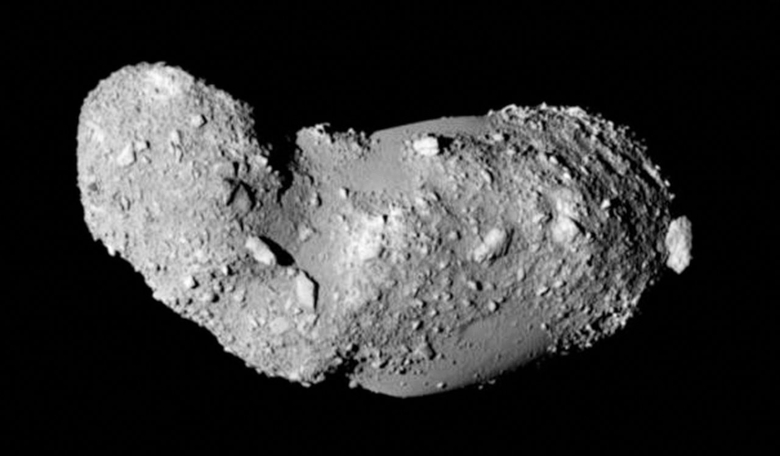Scientists studying a single grain of dust collected from an asteroid by JAXA’s first Hayabusa mission in 2010 and later returned to Earth, have found water and organic matter. This is the first time that organic materials essential for life on Earth have been found on the surface of asteroid.
Discovered on 26 September, 1998 by the Lincoln Laboratory Near-Earth Asteroid Research Team at Socorro, New Mexico, 25143 Itokawa, or Itokawa for short, became the first asteroid from which samples were captured and brought to Earth for analysis.
The samples were collected by Japan’s Hayabusa spacecraft; the predecessor to the more famous Hayabusa 2 craft which recently collected loose debris samples from asteroid Ryugu by firing a metal projectile into the rocky body’s surface.
Despite the failure of the mechanism designed to capture material on Itokawa, Hayabusa was still able to collect a small amount of dust and return it to Earth on 13 June, 2010.
With its distinct head and separate body part, Itokawa is said to resemble the shape of a sea otter and close-up observations of this oddly shaped asteroid, has led scientists to believe that it is not solid.
Instead it is suggested that the asteroid is an agglomeration of rocks loosely held together by their mutual gravity - in other words, it is a rubble pile.
This rubble pile, say a team of researchers behind a new study on the asteroid, has been constantly evolving over billions of years.
Along with extreme heating and dehydration, Itokawa has been sucking up water and organic materials from other extra-terrestrial sources, so that its chemistry has changed over time.
How do they know this? By examining Amazon; a tiny speck of dust, approximately 30 µm (micrometers) across at its widest and 50 µm long, and with a shape resembling the South America continent.
This minute particle has been bombarded with x-rays so that its water and mineral content can be determined.
Its analysis has shown that the organic matter within the grain has been heated to over 600°C in the past, says Dr Queenie Chan from the Department of Earth Sciences at Royal Holloway and lead author on this recent study.
Whereas the presence of unheated organic matter very close to it, “means that the in fall of primitive organics arrived on the surface of Itokawa after the asteroid had cooled down,” Chan added.
Being able to study ‘Amazon’ to such a high degree of precision has been a boon for Chan and her colleagues as past studies on the chemical precursors for the origin of life on Earth have focused heavily on C-type carbon-rich asteroids.
This is because S-type (stony) asteroids, the type which gives rise to the most popular type of meteorite found on Earth – chondrites – typically have low organic contents.
As such, studying the organic make-up of chondrites is challenging, especially when all you have to work on is a minute-sized speck of dust.
‘Amazon’, is helping to change all of that. “Studying ‘Amazon’ has allowed us to better understand how the asteroid constantly evolved by incorporating newly-arrived exogenous water and organic compounds,” Chan says.
Understanding the earliest chemical reactions involving liquid water is essential as it provides crucial insights to how simple building blocks of organic compounds evolve into increasingly bigger and more complex molecules and ultimately, how life started on Earth.
“These findings are really exciting as they reveal complex details of an asteroid’s history and how its evolution pathway is so similar to that of the prebiotic Earth,” Chan says.
When coupled with the knowledge that both JAXA’s Hayabusa2 and NASA’s OSIRIS-Rex missions have identified exogeneous materials on the target asteroids Ryugu and Bennu, respectively, our findings suggest that mixing of materials is a common process in our Solar System, Chan concludes.











